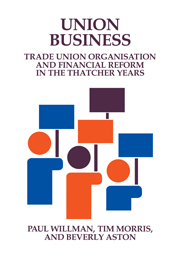Book contents
- Frontmatter
- Contents
- Acknowledgements
- 1 Introduction: unions in the 1980s
- 2 The financial status of British trade unions 1950–1989
- 3 Financial differences between unions
- 4 The role of financial matters in union organisation
- 5 The politics of union finaces
- 6 Union size, growth, and financial performance
- 7 Strike activity and union finances
- 8 The National Union of Mineworkers: strikes and financial disaster
- 9 The GMB: merger and financial reform
- 10 The Amalgamated Engineering Union: back from the brink
- 11 The Banking, Insurance and Finance Union: competitive unionism and financial survival
- 12 The Electrical, Electronic, Telecommunications and Plumbing Trade Union: accountability and financial control
- 13 Conclusions: union business and business unionism
- Appendix 1 Research methods
- Appendix 2 Regression results
- Appendix 3 Questions for finance officers
- Appendix 4 Questions for General Secretaries
- Appendix 5 Questionnaire: trade union finances
- Appendix 6 The number of trade unions
- Notes
- References
- Subject index
- Index of trade unions
- Author index
12 - The Electrical, Electronic, Telecommunications and Plumbing Trade Union: accountability and financial control
Published online by Cambridge University Press: 11 March 2010
- Frontmatter
- Contents
- Acknowledgements
- 1 Introduction: unions in the 1980s
- 2 The financial status of British trade unions 1950–1989
- 3 Financial differences between unions
- 4 The role of financial matters in union organisation
- 5 The politics of union finaces
- 6 Union size, growth, and financial performance
- 7 Strike activity and union finances
- 8 The National Union of Mineworkers: strikes and financial disaster
- 9 The GMB: merger and financial reform
- 10 The Amalgamated Engineering Union: back from the brink
- 11 The Banking, Insurance and Finance Union: competitive unionism and financial survival
- 12 The Electrical, Electronic, Telecommunications and Plumbing Trade Union: accountability and financial control
- 13 Conclusions: union business and business unionism
- Appendix 1 Research methods
- Appendix 2 Regression results
- Appendix 3 Questions for finance officers
- Appendix 4 Questions for General Secretaries
- Appendix 5 Questionnaire: trade union finances
- Appendix 6 The number of trade unions
- Notes
- References
- Subject index
- Index of trade unions
- Author index
Summary
Historical background
The Electrical, Electronic, Telecommunications, and Plumbing Trade Union (EETPU) was formed when the Electrical Trades Union (ETU) amalgamated with the Plumbers' Trade Union in 1968. Both the amalgamating parties have a history going back to the last century. ETU was formed in 1889. Local societies of plumbers existed before 1800 but it was not until 1865 that a national organisation was formed, the United Operative Plumbers' Association of Great Britain and Ireland.
Historically both ETU and PTU were craft unions aiming to control the supply and number of skilled electricians and plumbers through apprenticeship. However, the union now has over 23,000 women members, and a number of white-collar and managerial staff. It is currently facing a challenge to its skilled traditions with the upgrading of maintenance craftsmen to the status of ‘technician’, and is therefore facing the risk of losing these members to technical and white-collar unions like MSF. It has therefore been attempting to beef up its white-collar section (EESA) through mergers so that its more upwardly mobile skilled members are not tempted to transfer to staff associations or MSF which they may feel the rise in status justifies. The section has been successful in attracting a number of small unions and staff associations. The union's recent expulsion from the TUC has had the effect of increasing the number of white-collar merger partners from outside the TUC.
Skilled members are still the most important group within the union, comprising almost 55% of members. Clerical and technical workers comprise approximately 28%.
- Type
- Chapter
- Information
- Union BusinessTrade Union Organisation and Financial Reform in the Thatcher Years, pp. 185 - 198Publisher: Cambridge University PressPrint publication year: 1993



